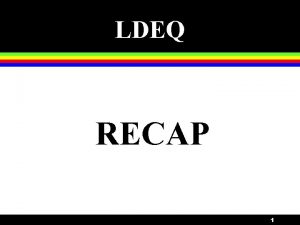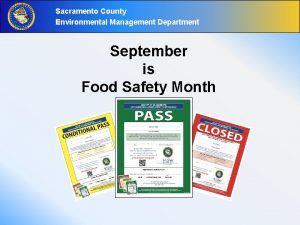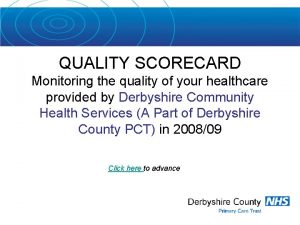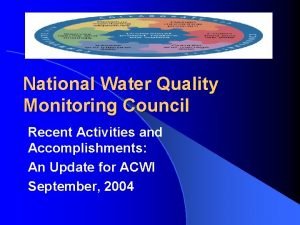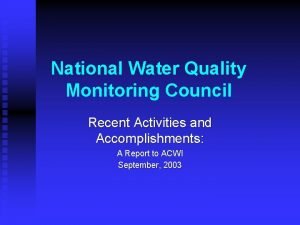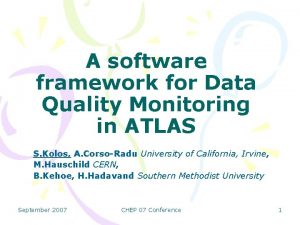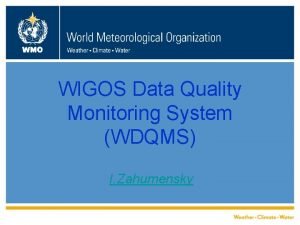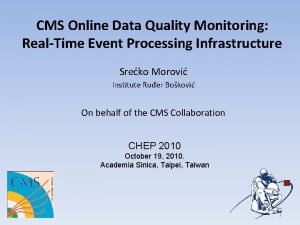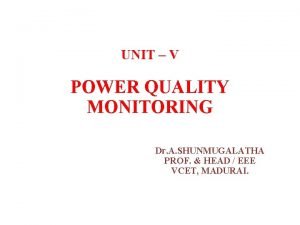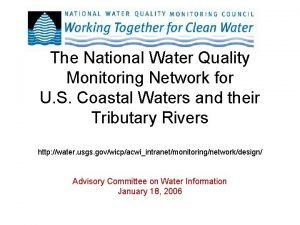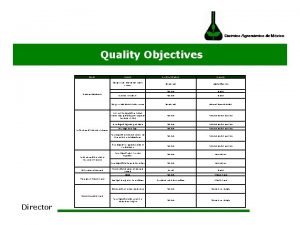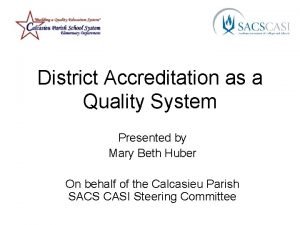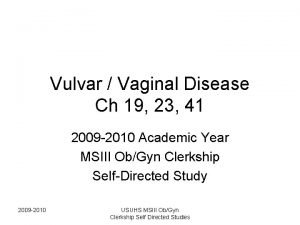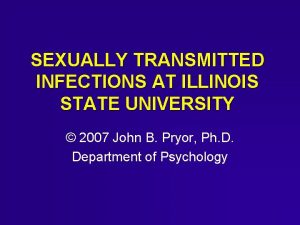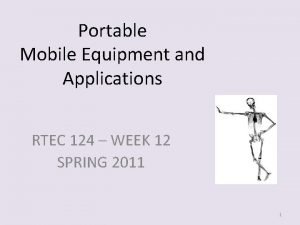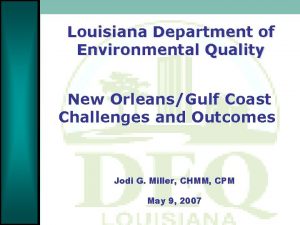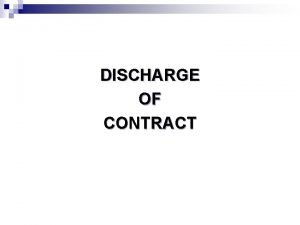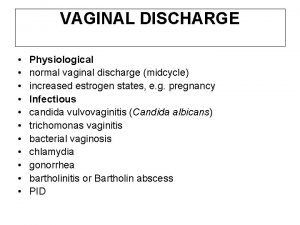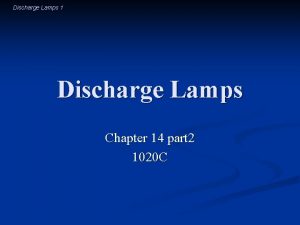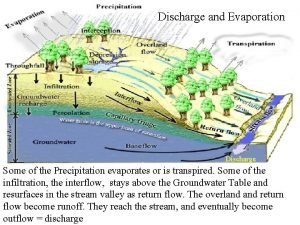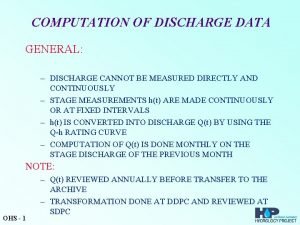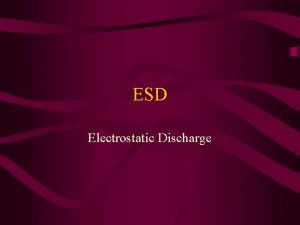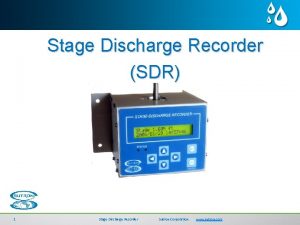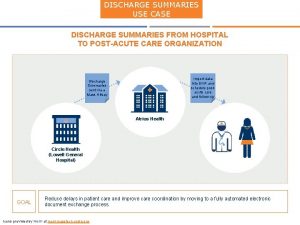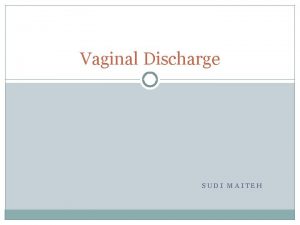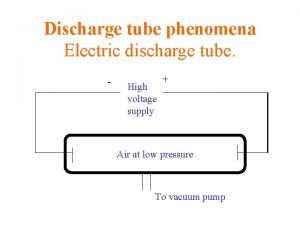Louisiana Department of Environmental Quality LDEQ Discharge Monitoring












































- Slides: 44

Louisiana Department of Environmental Quality (LDEQ) Discharge Monitoring Reports (DMRs) & Net. DMR

Discharge Monitoring Reports (DMRs)

How do I report my sample results? • Part II of the permit requires reporting of monitoring results on a Discharge Monitoring Report (DMR)form (EPA No. 3320 -1 or an approved substitute ). See LDEQ website--http: //www. deq. louisiana. gov/portal/ • If there is No Discharge during the monitoring period, it must be reported as such in the upper right corner of the DMR. • Submit DMRs to the Enforcement Division of the Office of Environmental Compliance.


Discharge Monitoring Reports: Instructions for Completion ess ing and. Name Permittee Name/Address 1. permittee. 2. Facility/Location - Enter if different from mailing address. itabbreviation State permit number as 3. Permit Number and appears on the NPDES permit, which consists of two alpha and seven numeric characters, normally. In case of General Permits, the first three characters will be alpha with the last six numeric. 4. Discharge Number (Outfall Number) Consist - combination aof of four alpha and numeric characters. (Examples: 001 A, 002 Q, 003 S, 004 Y). Some exceptions include, but are not limited to, biomonitoring/toxicity. The first two characters are TX, indicating toxicity testing. The last two characters are usually an assigned code used for Agency tracking purposes (Examples: TX 1 A, etc. )

Discharge Monitoring Reports: Instructions for Completion 5. Monitoring Period - From first day of monitoring period through last day of monitoring period. The dates should be displayed as MO DAY YR. Applicable monitoring periods will be specified in each permit. Some examples include but are not limited to: Type Designator Start Date End Date Monthly- A 01/01/2014 to 01/31/2014 Bi-mothly- B 01/01/2014 to 02/28/2014 Quarterly - Q 01/01/2014 to 03/31/2014 Semi-annual - S 01/01/2014 to 06/30/2014 Annual - Y 01/01/2014 to 12/31/2014

Discharge Monitoring Reports: Instructions for Completion 6. No Discharge - If the facility has no flow/no discharge for specific outfall and/or monitoring period, “NO DISCHARGE” must be indicated for that outfall and monitoring period. 7. Parameters -Specified in the permit as effluent characteristics for each discharge number (outfall), one parameter per box. Each box must display the parameter name and corresponding STORET code number. (Example: BOD (00310), p. H(00400), TSS(00530), Flow(50050)). The parameters should display on the DMR Form in numeric order by STORET code number. 8. Sample Measurement - Sample measurement data for each parameter. 9. Permit Requirement - Effluent limitations for each parameter as specified in the permit are displayed on the DMR under “Quantity or loading” and/or “Quality or Concentration”. Monitoring requirements for frequency of analysis and sample type as specified in the permit are also displayed. The DMR must reflect the most current monitoring and reporting period.

Discharge Monitoring Reports: Instructions for Completion 10. No. Ex. - Enter the number of sample measurements during the monitoring period that exceed minimum, maximum, or weekly average permit requirement for each parameter (If none, enter “ 0”) 11. Name/Title Principal Executive Officer or Authorized agent - See your permit for qualifications of Principal Executive Officer and signature authorization. 12. Signature - Original legible signature of authorized Principal Executive Officer or Authorized agent. Every page of the DMR must have an original signature. 13. Telephone - Telephone number of Principal Executive Officer. 14. Date - Actual date of signature certifying and authenticating data submitted on DMR.

Discharge Monitoring Reports: Instructions for Completion 15. Comments - May contain any clarifying information by either Agency or Permitee. 16. Note - The results of any additional monitoring of parameters at the location(s) designated in the permit, using approved analytical methods, must be included on the DMR (see part III. C. 8 of permit). 17. The most recent version of Discharge Monitoring Report can be found at: http: //www. deq. louisiana. gov/enforcement. 18. Revised DMRs - In the event a revised or corrected DMR is necessary, an original authorized signature and date of signature is required on each page. The word REVISED should be clearly visible on each of the pages of the form.

Reasons: 1. Missing Original Signature. 2. Missing Sample Measurements. 3. Parameters Not Reported. 4. Missing. -Frequency of Analysis. Env iron Reg men tal -Sample Type. ulat cod ory e -Number of Excursions. 5. Missing LPDES Number. 6. Missing Discharge Number(Outfall). 7. Missing Monitoring Period. 8. Incorrectly reported measurements. The Permittee is responsible for submitting complete, accurate and legible self-monitoring data.

Revised DMR Must Contain: 1. A New Original Signature. 2. Date of New Signature. 3. Clear Marking - “REVISED”. Env iro Reg nmen tal ulat cod ory e 4. Indicate what has been revised on the DMR. The Permittee is responsible for submitting complete, accurate and legible self-monitoring data.

John Smith 08/04/2011 Our original TSS data was incorrect; we are submitting a revised DMR that gives the correct information

Noncompliance Reporting The Permittee shall report any instance of noncompliance with its permit. Part III, Section D of the General Permits contain requirements for reporting: – Anticipated Noncompliance – 24 -hour reporting of conditions which may endanger health and the environment (via phone or fax), and – Any other Noncompliance that must be reported

Reports Must Contain: 1. Type of Violation. 2. Date of Violation. 3. Duration of Violation. 4. Cause of Violation. 5. Corrective Action Taken. 6. How Remediated.


COMMON ERRORS on DMRs • No Permit Number • Wrong Permit Number • Invalid Permit Number • has more/less than 7 digits • for generals, uses master general number instead of site specific • No Signature • Signature is a Copy • No Monitoring Period • Invalid Monitoring Period

COMMON ERRORS on DMRs • No Discharge Number • ex. 001 A, 002 Q • Missing Statistical Base Codes • MO AVG, WKLY AVG, DAILY MAX • Incorrect/Missing Limits, Units, Frequency, Sample Type • Reporting data in blanks that are not required by the permit • Reporting Min, Avg, and Max when only Max is required

MOST COMMONLY ASKED QUESTIONS How do I calculate and report Monthly Average? - Monthly Average is the arithmetic average of all results during one distinct calendar month - Results from different months can NOT be average together to calculate the monthly average - If samples are taken during more than one month during a monitoring period, then the highest monthly average shall be reported on the DMR How do I calculate and report Daily Maximum? -Daily Maximum is the maximum concentration measured on a single day, by the sample type specified in the permit -If samples are taken during more than one month during a monitoring period, then the highest daily maximum shall be reported on the DMR

MOST COMMONLY ASKED QUESTIONS How do I calculate and report 7 -day Averages? -We recognize that calendar weeks and calendar months rarely coincide. Therefore, for the purpose of calculating and reporting 7 -day averages, you should follow this process: A. Define your week (SUN-SAT, MON-SUN etc. ). B. Calculate the average of all sample data obtained for each week. C. The highest calculated weekly average will be reported on the DMR for the month in which(1) the week ends or (2) the week begins, or (3) the month which contains the greatest number of days. It is the choice of the permittee. However, the choice should be consistent month to month, year to year. SET A RULE AND STICK WITH IT.

MOST COMMONLY ASKED QUESTIONS How do I calculate geometric average (fecal only)? The geometric mean of a data set is given by: Multiply all sample values together and get the nth root (where n is the # of samples) Example: 4 Sample values of 150, 75, 200, 24 Multiplied together equal 54, 000 The 4 th root equals 85. 72 If you only have one sample, the 1 st root of that a number is that number. http: //www. easycalculation. com/statistics/geometric-mean. php

MOST COMMONLY ASKED QUESTIONS How do I report “too numerous to count” Coliform samples? Report TNTC on the DMR. A TNTC reported on the DMR exceeds the permit limit and is considered a permit violation. Actual numbers are required by the permit and should be reported when possible. How do I count number of exceedences? If daily maximum/daily minimum, count each sample that is below and/or above the maximum/minimum limit. If 7 -day average or weekly limit, every 7 - day average which exceeds the limit in the permit shall be counted as one exceedence. DO NOT INCLUDE 30 -DAY AVERAGES OR DAILY AVERAGES AS EXCEEDENCES ON DMRs.

MOST COMMONLY ASKED QUESTIONS Who can sign a DMR? See your permit for authorized signatory official. An authorization for anyone other than the person designated in the permit must be on file with the regulatory agency and signed by the permit signatory authority. Do I have to sign each page of my DMR? Yes. Each page must be signed. If any revisions are submitted, that revised page must also have an original signature and a new signature date.

Record Keeping • Records must be maintained for 3 years • Records must be presented upon request; for records maintained in a central or private office that is open during normal office hours and is closed at the time of inspection, the records shall be made available as soon as the office is open and no later than the close of business the next working day. • The types of records and the contents of the records are specified in the regulations: LAC 33: IX. 2701. J. 2&3 LAC 33: IX. 6515


Net. DMR Project Overview • Collaboration of 19 states using EPA grant money • Design began in September 2005 • LDEQ active in design process • Goal to provide interface for electronic DMR reporting that could be used nationally • Integrated with EPA’s national NPDES database

Net. DMR Implemented • EPA Installation Available – June 22, 2009 • LDEQ Implementation – June 22, 2009 – Phased Approach – Immediately available to major facilities – Minor permits added as resources allow and upon request

What does Net. DMR do? • Accepts DMR submissions electronically and pushes data directly to EPA’s national database • Creates signed XML document as versatile copy of record • Improves data flow from facilities to State/EPA

How it works… 1. User registration 2. Request/receive access to permit 3. Search/View DMR templates 4. Enter data (using online forms or importing feature) 5. Sign and Submit DMRs

Permit User Roles – Permit Administrator(s) • Responsible for facility/permit user management – Signatory Authority • Must have signatory authority • Can add, edit and submit reports – Data Provider • Can add/edit data, but not submit reports – Read-only



Web Form • Closely resembles current DMR form • Current limit information is pre-populated • Only allows data input in required/optional fields


Helpful Features • Data validity checks • Hard errors – DMR will not be accepted – e. g. alpha character in a numeric only field • Soft errors – Informational alerts – e. g. values which are exceedances of the permitted limit

Helpful Features (cont. ) • Highlighted limit violations • Ability to note reasons for missing data at the parameter level • Large comment area to include noncompliance report information • Ability to attach documents (does not become part of EPA national database)

Importing Data • Import the data for one or more DMRs by uploading a text file • Must still use the Net. DMR web form to: – Acknowledge soft errors – add DMR level information (comments/attachments) – Sign a completed DMR



Benefits of Net. DMR • Eliminates paper DMR data submittals • Improves data quality and availability • Encourages proper reporting • Provides email confirmation of DMR submission • Saves money on postage

Training • LDEQ offering training courses statewide – Next class is being held in Baton Rouge – Plan to continue quarterly classes throughout the state • EPA offers web based training periodically

Common Errors/Issues in Net. DMR • Choosing correct User Role during set-up • Forgetting • passwords • security question answers • that both are case sensitive • Attachments • not PDF format • have spaces in the file name

EPA E-Reporting Rule • EPA’s proposed e-reporting rule – http: //www 2. epa. gov/compliance/proposednpdes-electronic-reporting-rule • Main Impact on DMR submittal – Everyone will be required to use Net. DMR or a similar program to submit DMRs • draft rule requires this within 2 years of implementation – A hardship clause will be included for those who cannot readily access the internet

Questions or More Information? Kathy Huddle 225 -219 -3752 Christine Mayeux 225 -219 -3767 Ashley Viator 225 -219 -3810 www. deq. la. gov/netdmr deqnetdmr@la. gov

Louisiana Department of Environmental Quality (LDEQ) Discharge Monitoring Reports (DMRs) & Net. DMR
 Louisiana department of environmental quality ldeq
Louisiana department of environmental quality ldeq Mh 605
Mh 605 Ldeq recap
Ldeq recap Health standards louisiana
Health standards louisiana Nyc department of environmental protection
Nyc department of environmental protection County of sacramento environmental management department
County of sacramento environmental management department San diego department of environmental health
San diego department of environmental health Wa department of water and environmental regulation
Wa department of water and environmental regulation St lucie county environmental resources department
St lucie county environmental resources department Quality monitoring scorecard
Quality monitoring scorecard Quality monitoring scorecard
Quality monitoring scorecard National water quality monitoring conference
National water quality monitoring conference National water quality monitoring council
National water quality monitoring council Dqmf
Dqmf Wigos data quality monitoring system
Wigos data quality monitoring system Real time data quality monitoring
Real time data quality monitoring Permanent power quality monitoring equipment
Permanent power quality monitoring equipment Nwqmc conference
Nwqmc conference National water quality monitoring conference
National water quality monitoring conference Environmental quality survey
Environmental quality survey Bronx council for environmental quality
Bronx council for environmental quality Quality objectives for production department
Quality objectives for production department Huber & cisal joint quality department
Huber & cisal joint quality department Quality control in cutting department
Quality control in cutting department Perform quality assurance
Perform quality assurance Pmp quality management
Pmp quality management Quality metrics pmp
Quality metrics pmp Quality improvement vs quality assurance
Quality improvement vs quality assurance Quality improvement vs quality assurance
Quality improvement vs quality assurance Quality assurance vs quality control
Quality assurance vs quality control Management gurus and their contributions
Management gurus and their contributions Quality is free
Quality is free Old quality vs new quality
Old quality vs new quality Serosanguineous exudate
Serosanguineous exudate Yellow cottage cheese discharge
Yellow cottage cheese discharge Discharge meaning
Discharge meaning Lochia rubra
Lochia rubra Trichomoniasis discharge pictures female
Trichomoniasis discharge pictures female Std white discharge
Std white discharge Discharge messages
Discharge messages R410 pressure temperature chart
R410 pressure temperature chart Cnidocyte
Cnidocyte Capacitor discharge mobile x-ray units
Capacitor discharge mobile x-ray units Nematocyst discharge
Nematocyst discharge Nipple discharge color
Nipple discharge color


